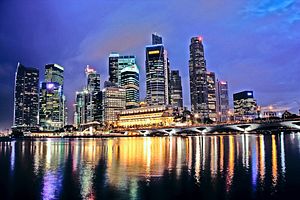China has joined the ranks of the world’s top 25 most innovative economies for the first time in the latest global survey. Can Asia sustain its rise up the rankings?
Western nations topped the leaderboard in the 2016 Global Innovation Index, with Switzerland placing first for the second straight year, followed by Sweden, Britain, and the United States. However, the Asia-Pacific region also featured, with Singapore moving up one place from the 2015 survey to sixth, South Korea gaining three spots to 11th, Hong Kong down three spots to 14th, Japan up three places to 16th, and neighbors New Zealand and Australia placing 17th and 19th, respectively.
Japan was among four economies that stood out in “innovation quality” – “a top-level indicator that looks at the caliber of universities, number of scientific publications, and international patent fillings,” said the report compiled by Cornell University, INSEAD, and the World Intellectual Property Organization.
Published annually since 2007, the 2016 index surveyed 128 economies based on 82 indicators, including institutions, human capital and research, infrastructure, market sophistication, business sophistication, knowledge and technology outputs, and creative outputs.
Meanwhile, China moved up four places to 25th overall and placed 17th in innovation quality, making it the leader among middle-income economies for this indicator. China is also the first such economy to break into the top 25 in the overall rankings, an area traditionally dominated by the highly developed economies.
“Only China has seen its R&D [research and development] expenditures or other innovation input and output metrics move closer to rich countries such as the USA,” the report said, noting that other middle income economies “remain distant.”
Elsewhere in Asia, Malaysia ranked 35th and Thailand 52nd among the region’s upper middle income economies, while Vietnam (59th) led the lower middle income economies, followed by the Philippines (74th) and Indonesia (88th). Low-income economy Cambodia placed 95th, with every economy within East and Southeast Asia and Oceania ranking within the top 100, unlike in 2015.
“The region’s strongest average performance is in the number of teachers per pupils and productivity growth, with lower scores in R&D financed by foreign firms, ICT [information and communications technology] services exports and imports, and intellectual property receipts,” the report said.
For regional leader Singapore, the city-state’s success has been built on “a steady and sustained approach to funding R&D as a critical pillar of Singapore’s economic development strategy.” The public R&D budget has grown from S$2 billion ($1.5 billion) under the 1991 five-year national technology plan to S$19 billion ($14 billion) in the latest 2020 plan, while business expenditure on R&D has grown from S$0.3 billion in 1990 to S$5.2 billion in 2014.
Openness to foreign investment and talent has been a hallmark of state policy, according to Lim Chuan Poh of Singapore’s Agency for Science, Technology and Research.
“Since the 1960s, the Singapore Economic Development Board pioneered a strategy of welcoming and attracting [multinational corporations] and foreign direct investment into Singapore – at a time when many other countries were, at best, still largely ambivalent about foreign investment and corporations,” he wrote.
Among the Asia-Pacific region’s leaders, Singapore scored highest for the quality of its institutions, ranking first globally for its political and regulatory environment, along with its top-ranked infrastructure, human capital, and research (ranked second globally) and business sophistication (first).
However, Hong Kong scored highest for market sophistication, where it ranked second globally, helped by its access to credit and investment and low trade barriers. South Korea ranked third globally for its human capital and research score and fifth for its knowledge and technology outputs, where it benefitted from its high number of patents, while New Zealand led the region in its creative outputs, where it ranked 12th globally.
Yet while Asia’s leaders have benefitted from “a strong and strategic coordination role of governments in innovation,” the report also cautions against governments picking winners and stifling organic innovation efforts.
Policymakers should provide sufficient incentives and a certain “freedom to operate” that also challenges the status quo, it said. “Developing countries are well advised to avoid over relying on government forces as the sole driver to orchestrating a sound innovation system,” the report cautioned.
The report also noted a decline in R&D expenditure following the 2009 global financial crisis. From a pre-crisis growth rate of around 7 percent a year, global R&D spending grew by only 4 percent in 2014, reflecting slower growth in emerging economies and tighter budgets in advanced economies.
“Investing in innovation is critical to raising long-term economic growth,” WIPO director general Francis Gurry said. “In this current economic climate, uncovering new sources of growth and leveraging the opportunities raised by global innovation are priorities for all stakeholders.”
Asia’s Innovative Companies
Asia’s rise up the global innovation rankings has also been reflected in its businesses.
A number of Asia-based companies featured in Forbes magazine’s “World’s Most Innovative Companies 2016,” which ranks businesses on their ability to be innovative “now and in the future” based on its “innovation premium.”
Asia’s leaders comprised consumer goods maker Unilever Indonesia (ranked eighth), South Korean internet company Naver (13th), Shanghai RAAS Blood Products (16th), Japanese e-commerce company Rakuten (17th), Indonesia’s Asian Paints (18th), and South Korea’s LG Household & Health Care (19th) and personal products maker Amorepacific (21st).
A separate survey by Fast Company magazine ranked China’s Huawei 13th “for taking the upper hand in the global mobile competition,” while Japanese architectural firm SANAA placed 30th for “upping the ante on architectural biomimicry” and Singapore’s BeMyGuest ranked 33rd “for taking Asian travelers off the beaten path.”
Having surged up the leaderboard for both public and private innovation, Asia’s next challenge will be ensuring its emerging giants including China and India continue to move up the rankings, while not leaving the lower ranked economies behind.

































